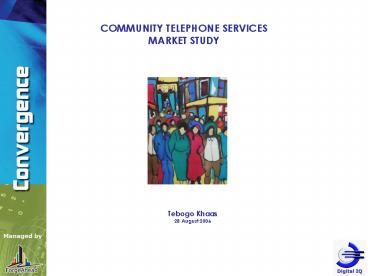COMMUNITY TELEPHONE SERVICES MARKET STUDY - PowerPoint PPT Presentation
1 / 19
Title:
COMMUNITY TELEPHONE SERVICES MARKET STUDY
Description:
Project Scope & Methodology ... based on a 1-month time constraint, the project scope was ... KwaZulu Natal. Mthonjaneni. 43.46% Eastern Cape. Elundini ... – PowerPoint PPT presentation
Number of Views:16
Avg rating:3.0/5.0
Title: COMMUNITY TELEPHONE SERVICES MARKET STUDY
1
COMMUNITY TELEPHONE SERVICESMARKET STUDY
Tebogo Khaas28 August 2006
2
Introduction
- Three underlying drivers are critical to
understanding the need for the information
included in this study - The need to provide telecommunications access and
services to under-serviced communities as key to
delivering on its developmental objectives - Mandatory service obligations such as Community
Service Telephones (CSTs) - The need to evaluate the efficacy and need for
further intervention
3
Objective Scope of Study
- The objective and scope of the study was to
evaluate the following - The current extent of CST penetration within
South Africa - The future requirements for CST within the
territory and - The propensity of the market to absorb additional
CSTs of the nature as proposed for the operators
(roughly 90 000).
4
Project Scope Methodology
- Due to the original understanding based on a
1-month time constraint, the project scope was
limited and consequently, this is a high-level
market study confined to larger geographical
areas. - The following caveats have been identified for
this study - The total sample size of 150 telephone interviews
provided valuable information about the sector
but the study should not be seen as being
representative of the industry in total. - The outputs of the study should be seen as
guidelines to inform policy development and not
an exhaustive source of industry information. - The research model used consisted of three major
phases. During the first phase, an analysis of
the level(s) of penetration by CSTs within the
territory was made. During the second phase, an
analysis of the need that exists for telephone
services was made.
5
3.1 Executive Summary - Data Analysis
6
(No Transcript)
7
(No Transcript)
8
Average Annual Communication Spend as Percentage
of Total Average Annual Household Income
Source Statistics South Africa
9
Average Annual Communication Spend as a of
Average Annual Income Urban vs. Rural Households
Source Statistics South Africa
10
Households per Province with no access to a
Telephone
Source Statistics South Africa
11
Percentage of Households which have no access to
Telephones Provincial Breakdown
Source World Development Indicators Database
World Bank
12
Top 20 Municipalities - Households with no access
to telephones
13
Demographic breakdown of South Africa Area
(Square Kms)
Source Statistics South Africa
14
Population density figures growth in population
per province
Source Statistics South Africa Based on 1996
2001 Census Data
15
Correlation between income per household and
households without access to phones
16
Correlation between income per household and
households without access to phones
- Previous figure confirms the correlation as
identified between the average income per
household per Municipality and the percentage of
households per Municipality that do not have
access to telephone services. - Municipalities where the average households earn
relatively low income per month tend to have more
households without access to telephone services.
This is illustrated in previous figure where it
can be noted that on average when the average
income per household per Municipality spikes
upwards, the percentage of households without
access to telephones shows a relatively similar
downward spike.
17
Main Findings
- From the analysis obtained from the study with
all its limitations, the following findings have
been arrived at - Urban areas currently enjoy the highest CST
penetration compared to rural areas. Due to their
relatively higher disposable income, these
generally seem to enjoy much preference in
respect to CST rollout than the rural or
peri-urban areas. Poorer provinces lag behind
those with higher household income in terms of
penetration of CSTs per capita. Long term
sustainability and business viability are cited
as the main reason for this phenomenon
18
Main Findings
- Based on the sample interviews made, future
requirements of CSTs within the territory remain
strong in spite of the serious competition posed
by the growth of public telephone service
operators and - The analysis suggests the market can absorb
additional CSTs of the nature as proposed for the
operators. However due the serious competition
faced by CSTs in their current form, focus could
shift to proving more data services than voice
services at existing and new CST installations as
the demand for data services is likely to grow
exponentially, especially in under-serviced
areas, in line with national trends and the
growth in the black middle class.
19
Thank You































